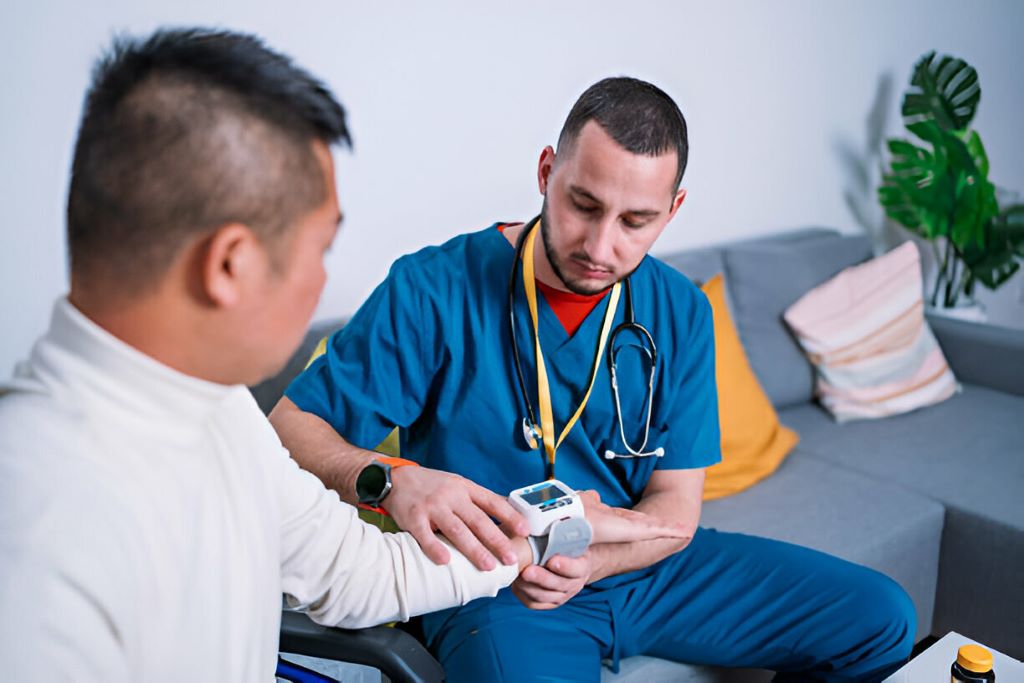In recent years, there has been a significant shift in the way healthcare is delivered and managed, thanks to advances in technology.
One area that has seen remarkable growth and innovation is remote patient monitoring (RPM), particularly through the use of wearable devices.
Equipped with sensors and connectivity features, these devices enable healthcare providers to monitor patients’ vital signs and health metrics remotely.
This facilitates early detection of health issues, and proactive intervention, and ultimately leads to improved outcomes. In the following article, we will delve into the evolution of wearable remote patient monitoring devices, examining their benefits, challenges, and potential to revolutionize healthcare.
The Evolution of Remote Patient Monitoring
Remote patient monitoring has its roots in telemedicine and telehealth, which have been around for decades. However, traditional telehealth solutions often relied on phone calls, video conferencing, or specialized medical equipment installed in patients’ homes.
While these methods provided some level of remote monitoring and consultation, they were limited in their ability to capture real-time data and provide continuous monitoring of patient’s health status.
The advent of wearable technology, coupled with advances in sensors, connectivity, and data analytics, has transformed remote patient monitoring into a more effective and accessible solution.
Wearable devices like smartwatches, fitness trackers, and specialized medical sensors can gather a diverse array of health metrics, including heart rate, blood pressure, blood glucose levels, oxygen saturation, and activity levels, among others.
DelveHealth leads this advancement with its cutting-edge range of wearable devices, providing patients with immediate feedback and practical insights to take charge of their health proactively.

Benefits of Wearable Remote Patient Monitoring
The adoption of wearable remote patient monitoring devices offers numerous benefits for both patients and healthcare providers:
- Early Detection of Health Issues: Continuous monitoring of vital signs and health metrics allows for early detection of abnormalities or changes in a patient’s health status. This enables timely intervention and prevents the progression of health problems.
- Improved Chronic Disease Management: Patients with chronic conditions such as diabetes, hypertension, and heart disease can benefit from regular monitoring of their health parameters. Wearable devices provide valuable insights into disease management and help patients and providers make informed decisions about treatment plans.
- Enhanced Patient Engagement: Wearable devices empower patients to take control of their health by providing them with real-time feedback and actionable insights. Patients are more likely to adhere to treatment plans and make healthier lifestyle choices when they are actively monitoring their health.
- Reduced Healthcare Costs: By preventing unnecessary hospitalizations, emergency room visits, and complications associated with untreated health issues, wearable remote patient monitoring can lead to significant cost savings for healthcare systems and payers.
- Remote Monitoring of At-Risk Populations: Wearable devices are particularly beneficial for monitoring at-risk populations, such as the elderly, patients with multiple chronic conditions, and those living in remote or underserved areas. Remote monitoring allows these individuals to receive timely care and support without the need for frequent clinic visits.

Challenges and Considerations
While wearable remote patient monitoring holds great promise, several challenges must be addressed to realize its full potential:
- Data Security and Privacy: The collection, transmission, and storage of health data raise concerns about privacy and security. Healthcare organizations must implement robust data security measures to protect patient information from unauthorized access or breaches.
- Integration with Healthcare Systems: Wearable remote patient monitoring solutions need to seamlessly integrate with existing healthcare systems, including electronic health records (EHRs) and clinical workflows. Interoperability standards and protocols play a crucial role in ensuring data exchange and collaboration across different platforms and providers.
- Regulatory Compliance: Regulatory frameworks, such as the Health Insurance Portability and Accountability Act (HIPAA) in the United States and the General Data Protection Regulation (GDPR) in Europe, govern the collection, use, and sharing of personal health information. Wearable remote patient monitoring devices must comply with these regulations to ensure patient confidentiality and data protection.
- User Adoption and Engagement: Successful implementation of wearable remote patient monitoring depends on user adoption and engagement.
- Reimbursement and Financial Incentives: The lack of reimbursement for remote patient monitoring services is a barrier to widespread adoption. Healthcare payers and policymakers need to develop reimbursement models and financial incentives that incentivize providers to invest in remote monitoring technologies and services.
Future Directions and Opportunities
Despite these challenges, the future of wearable remote patient monitoring looks promising. As technology continues to evolve, we can expect to see further improvements in wearable devices’ accuracy, reliability, and usability.
Advanced sensors, artificial intelligence (AI), and machine learning algorithms will enable more sophisticated health monitoring capabilities, personalized insights, and predictive analytics.
Furthermore, the integration of wearable devices with other digital health tools, such as telemedicine platforms, virtual care solutions, and patient portals, will create a seamless and holistic approach to healthcare delivery.
Remote patient monitoring will become an integral part of preventive care, chronic disease management, and population health management strategies.

Conclusion
Wearable remote patient monitoring devices represent a transformative technology that has the potential to revolutionize healthcare delivery and improve patient outcomes.
By enabling continuous monitoring of patient’s health status, early detection of health issues, and proactive intervention, wearable devices empower patients to take control of their health and support healthcare providers in delivering more personalized and efficient care.
As the field continues to evolve, addressing challenges related to data security, interoperability, user adoption, and reimbursement will be critical to realizing the full benefits of wearable remote patient monitoring.
With collaboration among stakeholders, including healthcare providers, technology developers, policymakers, and patients, we can harness the power of wearable devices to create a healthier and more connected future.



